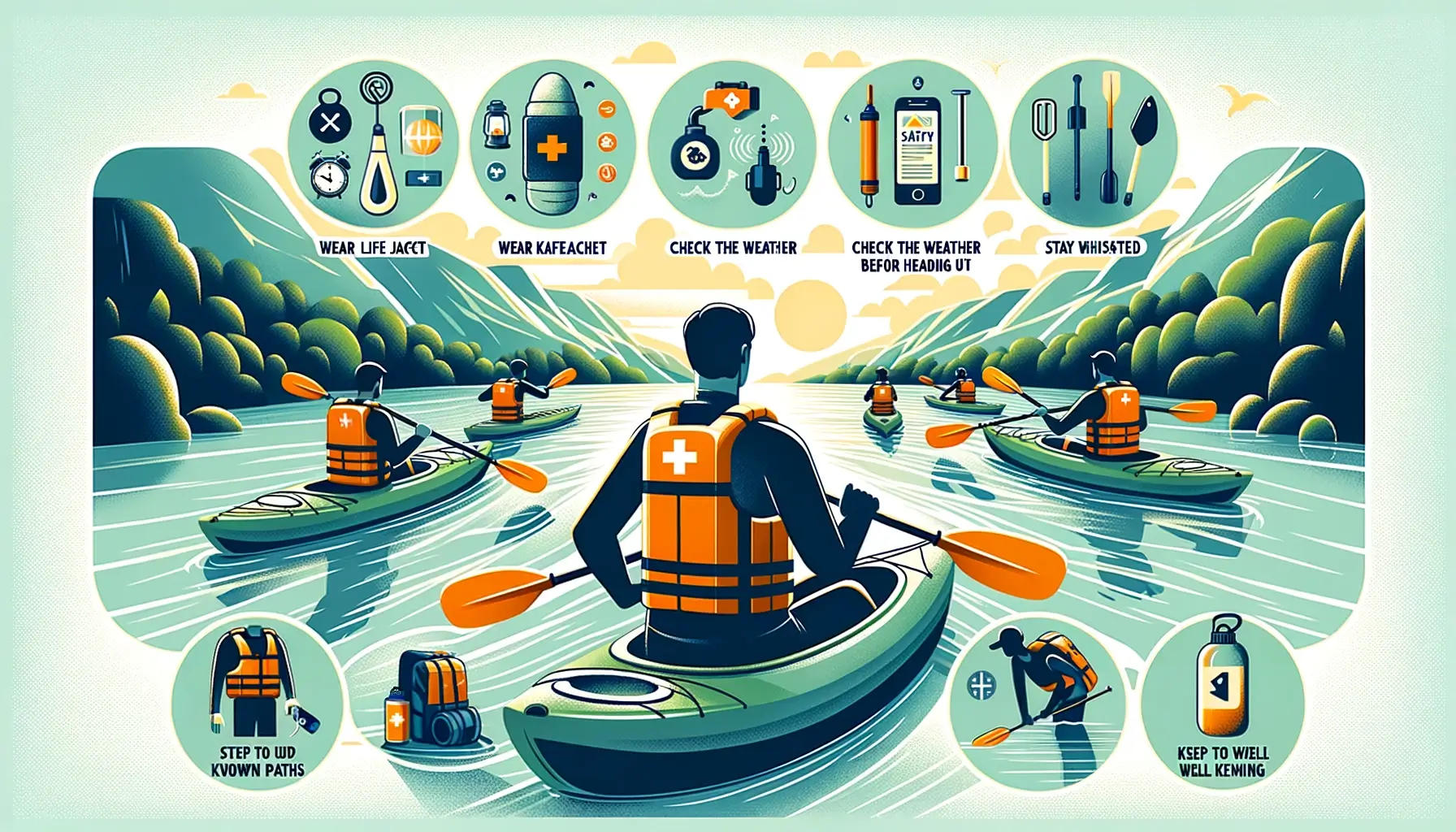It is illegal to kayak without a life jacket as it violates boating safety regulations. Kayakers must always wear a life jacket as a safety precaution, ensuring their protection in case of emergencies on the water.
Kayaking is a popular recreational activity that allows people to explore the beauty of nature and experience an adventurous outdoor sport. However, safety should always come first to prevent accidents and ensure an enjoyable experience. Being prepared with the necessary equipment, such as a life jacket, is essential to mitigate risks and enjoy kayaking responsibly.
Understanding the regulations and safety guidelines for kayaking can help keep individuals safe and make the most of their outdoor adventures.
Legal Requirements For Kayaking
When it comes to kayaking, knowing the legal requirements is crucial for your safety and to avoid any potential legal repercussions. One of the most important aspects of kayaking is wearing a life jacket or personal flotation device (PFD). However, there are also local, state, and federal laws that you need to be aware of before heading out on the water. Here is an overview of the different legal requirements you should keep in mind:
Local Laws And Regulations
In addition to state and federal laws, it’s essential to understand the local laws and regulations that apply to kayaking in your area. These can vary depending on the specific body of water or the governing jurisdiction. Here are some common local regulations that you may come across:
- Specific areas or zones where kayaking is prohibited
- Rules regarding kayaking in designated wildlife sanctuaries
- Speed limits or restrictions in certain areas
- Restrictions on launching or mooring kayaks
- Mandatory permits or licenses for kayaking in certain locations
Make sure to research and familiarize yourself with the local laws before embarking on your kayaking adventure.
State Laws
State laws play a significant role in regulating kayaking activities. These laws often cover various aspects, including the following:
- Mandatory use of life jackets or PFDs
- Age requirements for kayaking alone or without adult supervision
- Equipment specifications, such as lights or reflectors for night kayaking
- Rules regarding alcohol or drug use while kayaking
- Restrictions on kayaking in certain weather conditions or during specific seasons
It’s important to note that these laws can vary from state to state, so what applies in one state may not apply in another. Take the time to understand the specific laws in your state to ensure compliance and safety.
Federal Laws
In addition to local and state laws, federal laws also come into play when it comes to kayaking. Here are some key federal laws that kayakers should be aware of:
- U.S. Coast Guard regulations, particularly for activities on navigable waters
- Life jacket requirements for kayakers on federal waters
- Rules regarding navigation and right of way
- Permits or licenses for kayaking in protected areas, such as national parks or wildlife refuges
Federal laws are designed to ensure safety and environmental protection, so it’s crucial to adhere to them while kayaking on federal waters.
Remember, the information provided here is a general overview, and there may be additional laws or regulations that apply to specific locations or circumstances. To ensure your safety and compliance with the law, always check for the most up-to-date information and consult local authorities or kayak clubs in your area.
Importance Of Life Jackets

Wearing a life jacket while kayaking ensures your safety on the water.
Not wearing a life jacket increases the risk of drowning while kayaking.
Life jackets come in different types, including inflatable, foam, and hybrid designs.
Safety On The Water
Wearing a life jacket ensures safety while kayaking.
Drowning Risks
Not wearing a life jacket increases drowning risks during water activities.
Types Of Life Jackets
Life jackets vary in types such as inflatable, foam, and hybrid designs.
Consequences Of Kayaking Without A Life Jacket
Kayaking without a life jacket can have serious consequences. Not only is it illegal in many places, but it also puts your safety at risk. Make sure to always wear a life jacket when kayaking to protect yourself and avoid legal trouble.
Fines And Penalties
One of the consequences of kayaking without a life jacket is the potential for facing fines and penalties. Many jurisdictions have strict laws in place requiring kayakers to wear a life jacket at all times while on the water.
When caught kayaking without a life jacket, you could be subjected to hefty fines. The exact amount varies depending on the location, but it is common for fines to be several hundred dollars.
In addition to fines, you may also face other penalties such as points on your boating or driver’s license. These points could lead to the suspension of your license or increased insurance rates.
Safety Concerns
Kayaking without a life jacket poses significant safety concerns that should not be ignored. Wearing a life jacket is not only a legal requirement but also a crucial safety measure to protect yourself in case of accidents or emergencies.
While kayaking, unexpected circumstances such as strong currents, sudden weather changes, or equipment failure can occur. In these situations, a life jacket can mean the difference between life and death.
A life jacket keeps you afloat if you capsize, enabling you to conserve energy until help arrives. It also provides visibility to search and rescue teams, increasing the chances of being found quickly.
Furthermore, even the strongest swimmers can find themselves in danger when kayaking without a life jacket. Fatigue, cold water, and unexpected obstacles can quickly lead to exhaustion, making it difficult to swim to safety without the buoyancy support of a life jacket.
Remember, accidents can happen to even the most experienced and cautious kayakers. In an unpredictable water environment, a life jacket is your best defense against tragedy.
Exceptions To Wearing A Life Jacket
When it comes to kayaking, safety should always be a top priority. However, there are exceptions to the requirement of wearing a life jacket in certain situations and for specific individuals.
Age Exemptions
In many jurisdictions, there are age exemptions when it comes to the mandatory use of life jackets for kayaking. Usually, children under a certain age, often around 12 years old, are required to wear a life jacket at all times while kayaking.
Competitive Kayaking
Competitive kayaking is another exception where the use of a life jacket may not be required, especially during organized and supervised racing events. These competitive events often have their own safety regulations and may allow participants to forego wearing a life jacket due to the nature of the competition and the presence of rescue personnel.
Specific Water Conditions
Specific water conditions can also warrant an exception to wearing a life jacket. For example, in calm and shallow waters where the risk of drowning is extremely low, authorities may not enforce the mandatory wearing of life jackets. However, it’s important to consider that weather and water conditions can change rapidly, so it’s always best to err on the side of caution and wear a life jacket whenever kayaking.
Tips For Kayaking Safely

Kayaking is a fantastic way to enjoy the great outdoors and get closer to nature. However, like any water activity, safety should be a top priority. Here are some essential tips for kayaking safely:
Always Wear A Life Jacket
A life jacket is a crucial piece of safety equipment for kayaking. Accidents can happen suddenly, and wearing a life jacket can save your life, especially if you encounter rough waters or unexpected weather conditions.
Check Local Regulations
Before heading out for a kayaking adventure, it’s important to familiarize yourself with the local regulations. Some areas may have specific rules regarding kayaking and life jacket requirements, so make sure to adhere to them to avoid any legal complications.
Keep An Eye On Weather Conditions
Weather conditions can change rapidly, and it’s essential to stay informed about the forecast before setting off on a kayaking trip. Unpredictable weather can pose significant risks, so always be mindful of any potential storms or adverse conditions and plan your excursion accordingly.
Frequently Asked Questions Of Is It Illegal To Kayak Without A Life Jacket
Is Kayaking Without A Life Jacket Illegal?
Kayaking without a life jacket can be illegal in various circumstances and locations. It’s important to research and understand the specific laws in your area to ensure compliance.
What Are The Consequences Of Kayaking Without A Life Jacket?
Kayaking without a life jacket can lead to fines, legal repercussions, and, most importantly, an increased risk of injury or drowning. It’s essential to prioritize safety while enjoying water activities.
Can A Kayak Capsize Even In Calm Waters?
Yes, a kayak can capsize even in calm waters due to various factors such as sudden shifts in weight, unexpected waves, and other environmental conditions. It’s crucial to always be prepared for such situations and wear a life jacket for safety.
Conclusion
It is crucial to prioritize safety when kayaking and always wear a life jacket. Neglecting to do so not only puts your own life at risk but may also lead to legal consequences. Remember, laws regarding life jacket usage may vary depending on your location, but it is generally considered mandatory for safety reasons.
So, stay smart and stay safe on the water by ensuring you have a life jacket on at all times.
